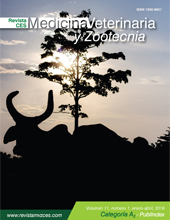Seroprevalence and risk factors of several bovine viral diseases in dairy farms of San Pedro de los Milagros, Antioquia, Colombia
Resumen
Bovine viral diarrhea virus (BVDV), Bovine herpesvirus-1 (BoHV-1) and enzootic bovine leucosis (EBL) are viral infections that cause three of the most important cow diseases in the world. Antibody detection is the quickest and most cost-effective method to detect exposition to the virus. The aim of this study was to determine the seroprevalence and risk factors associated with these diseases in cows from the town of San Pedro de los Milagros, Antioquia. A total of 791 bovines of 24 dairy farms were sampled for blood between may and june of 2014, and analized for antibodies against BVDV and BoHV-1. These 24 farms plus other five were analized for antibodies against EBL for a total of 1003 bovines from 29 farms sampled. All tests were done with ELISA kits commercially available. The risk factors for farm and cow selected were evaluated to analize their relation with the serological state of these three diseases using logistic regression. In general, seroprevalence at the animal level for BVDV BoHV-1 and EBL was 75.7% (95% CI: 68.7–82.6%), 31.1% (95% CI: 22.1–40.1%) and 47.8% (95% CI: 40–55.7%), respectively. The odds ratio of being seropositive for BoHV-1 was significantly higher (OR=3.0) in animals older than 3 years in comparison to bovines younger than a year. Not using disposable needles was associated with prevalence of EBL. In conclusion there was a high seroprevalence of EBL and BVDV, and a lower one for BoHV-1. Seropositivity to BoHV-1 was associated with cows older than 3 years and seropositivity to EBL was associated with not using disposable needles in the farm.
Descargas
Descargas
Publicado
Cómo citar
Número
Sección
| Estadísticas de artículo | |
|---|---|
| Vistas de resúmenes | |
| Vistas de PDF | |
| Descargas de PDF | |
| Vistas de HTML | |
| Otras vistas | |



